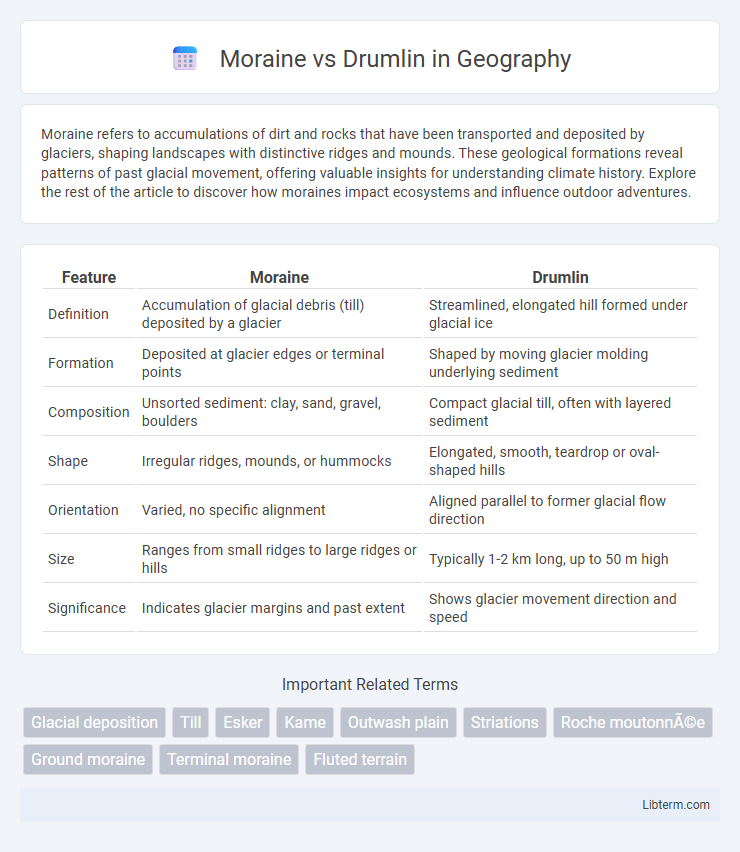Moraine refers to accumulations of dirt and rocks that have been transported and deposited by glaciers, shaping landscapes with distinctive ridges and mounds. These geological formations reveal patterns of past glacial movement, offering valuable insights for understanding climate history. Explore the rest of the article to discover how moraines impact ecosystems and influence outdoor adventures.
Table of Comparison
| Feature | Moraine | Drumlin |
|---|---|---|
| Definition | Accumulation of glacial debris (till) deposited by a glacier | Streamlined, elongated hill formed under glacial ice |
| Formation | Deposited at glacier edges or terminal points | Shaped by moving glacier molding underlying sediment |
| Composition | Unsorted sediment: clay, sand, gravel, boulders | Compact glacial till, often with layered sediment |
| Shape | Irregular ridges, mounds, or hummocks | Elongated, smooth, teardrop or oval-shaped hills |
| Orientation | Varied, no specific alignment | Aligned parallel to former glacial flow direction |
| Size | Ranges from small ridges to large ridges or hills | Typically 1-2 km long, up to 50 m high |
| Significance | Indicates glacier margins and past extent | Shows glacier movement direction and speed |
Introduction to Moraines and Drumlins
Moraines are accumulations of glacial debris formed along the edges or terminus of glaciers, consisting of unsorted rocks, soil, and sediment. Drumlins are streamlined, elongated hills of glacial deposits shaped beneath moving ice, typically composed of compacted till. Both landforms provide crucial insights into past glacial movement and dynamics.
Defining Moraines: Formation and Features
Moraines are accumulations of glacial debris such as rocks and soil deposited by melting glaciers, forming ridges or mounds that mark the glacier's former edges. These landforms consist predominantly of till, an unsorted mixture of sediments ranging from fine silt to large boulders, shaped during glacial advance and retreat phases. Unlike drumlins, which are streamlined hills formed beneath moving ice, moraines represent stationary or terminal deposition zones, providing critical evidence of glacier dynamics and past ice extent.
Understanding Drumlins: Origins and Characteristics
Drumlins are streamlined, elongated hills composed primarily of glacial till, formed under moving ice sheets during the last Ice Age. Their characteristic teardrop shape, with a steep stoss slope facing the direction from which the glacier advanced and a gentle lee slope pointing downstream, indicates the ice flow direction and distinguishes them from moraines, which are accumulations of unsorted debris deposited at glacier margins. Understanding drumlins involves analyzing their sediment composition, orientation, and distribution, revealing insights into past glacial dynamics and landscape evolution.
Geological Processes Behind Moraines and Drumlins
Moraines form from the accumulation of glacial debris deposited directly by moving ice, often marking the edges or terminal positions of glaciers. Drumlins develop through the streamlined reshaping of sediment beneath a glacier by ice flow, creating elongated hills aligned with the direction of glacial movement. Both landforms result from complex interactions between ice dynamics, sediment transport, and subglacial geology during glacial advance and retreat.
Key Differences Between Moraines and Drumlins
Moraines consist of unsorted glacial debris deposited at the edges or terminus of glaciers, whereas drumlins are streamlined, elongated hills formed beneath moving ice sheets composed mainly of compacted till. Moraines vary in size and shape, appearing as ridges or mounds, while drumlins exhibit a consistent teardrop shape aligned with ice flow direction. The primary difference lies in formation processes: moraines result from sediment accumulation, and drumlins develop through subglacial reshaping of sediments by glacial movement.
Types of Moraines and Their Significance
Lateral, medial, and terminal moraines are key types of glacial deposits marking the edges and extent of advancing glaciers. Lateral moraines form along glacier sides, while medial moraines appear as ridges in the center where two glaciers converge, and terminal moraines indicate the furthest point of glacial advance. These moraines provide critical insights into past glacial dynamics, climate change patterns, and landscape evolution.
Variations Among Drumlins: Shapes and Sizes
Drumlins display a wide variety of shapes and sizes, influenced by factors such as ice flow velocity and sediment composition, ranging from elongated, streamlined hills to more rounded forms. These geomorphological features typically measure between 200 meters to over 2 kilometers in length, with heights varying from 15 to 50 meters, reflecting the dynamic processes of glacial movement. Unlike moraines, which accumulate debris at glacier termini, drumlins are sculpted beneath the glacier, resulting in their distinctive shape that aligns with past ice flow direction.
Ecological and Environmental Importance
Moraines and drumlins both play crucial roles in shaping ecosystems by influencing soil composition and water drainage patterns. Moraines, composed of unsorted glacial debris, create diverse habitats supporting unique plant and animal species, while drumlins, streamlined hills formed from glacial till, affect microclimates and promote varied vegetation growth. These glacial landforms contribute to groundwater recharge and serve as natural barriers that protect wetlands and other sensitive environments.
Notable Locations with Moraines and Drumlins
Notable locations featuring moraines include the Long Island moraine system in New York and the terminal moraines of the Great Lakes region, illustrating glacial deposits shaping the landscape. Prominent drumlin fields are found in the Boston Basin, Massachusetts, and the drumlin-rich terrain of Upstate New York, showcasing elongated hills formed by glacial ice movement. Both landforms provide critical insights into past glacial activity and regional geomorphology.
Conclusion: Comparing Moraines and Drumlins
Moraines and drumlins both represent glacial landforms but differ significantly in formation and morphology. Moraines are accumulations of unsorted debris deposited directly by glacier ice, often forming ridges, while drumlins are streamlined hills shaped beneath moving ice, composed of compacted till. Understanding these distinctions highlights the dynamic processes of glacial activity and the landscape evidence they leave behind.
Moraine Infographic

 libterm.com
libterm.com